2020 | OriginalPaper | Buchkapitel
16. Digital Dissent and Censorship in the Kashmir Conflict
verfasst von : Arif Hussain Nadaf
Erschienen in: Platforms, Protests, and the Challenge of Networked Democracy
Verlag: Springer International Publishing
Aktivieren Sie unsere intelligente Suche, um passende Fachinhalte oder Patente zu finden.
Wählen Sie Textabschnitte aus um mit Künstlicher Intelligenz passenden Patente zu finden. powered by
Markieren Sie Textabschnitte, um KI-gestützt weitere passende Inhalte zu finden. powered by
